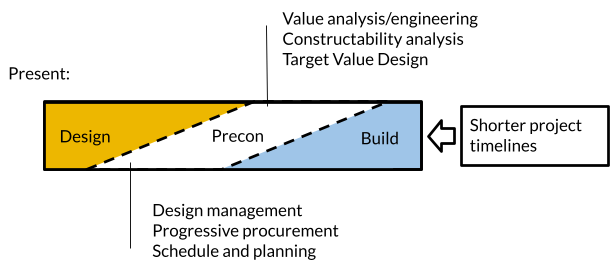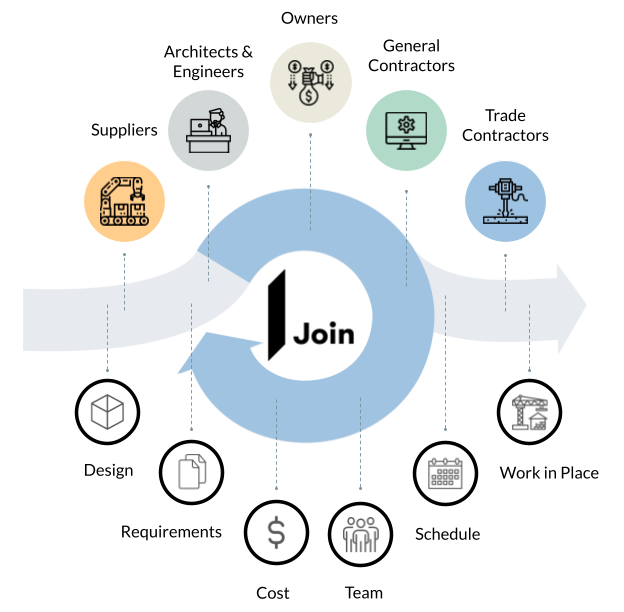How Preconstruction Has Changed and What You Need to Know About its Future
Preconstruction: Past, Present, and Possibilities
The key to successful project outcomes is to make better decisions earlier.
The construction industry deserves the chance to make better decisions early when substantial impacts to performance and cost are possible. This ability has emerged in other industries such as manufacturing, where digital technologies to simulate, model and collaborate around products early in their development cycle have delivered in big ways. Construction brings its own complications: inherent complexity and uniqueness in each project, and a resulting fragmented team of stakeholders.
At Join, we are building a set of platform technologies to enable teams to get the most out of every project. We believe that to empower teams to realize potential, we must provide tools that allow multiple stakeholders to work together with a real-time and structured view of the project, augmented by intelligence systems to explore the full range of design and procurement opportunities that a global supply chain can offer.
We view the rise of preconstruction as one of the most exciting trends in the construction industry: it’s where the right set of stakeholders are involved and incentivized to move. Preconstruction is changing, and we wanted to share what we see and where we see opportunities for a software technology to support teams.
What is Preconstruction?
The view of preconstruction as “the work done after a design is finished and before building begins,” and focused on translating an architect’s vision into plans that can be executed is anachronistic and misses the transformation that has already occurred in project delivery methods to emphasize early collaborative involvement of the construction team.
80% of the work delivered in the United States now utilizes a Design-Build or Construction-Manager-At-Risk delivery method.
This is a trend that has revolutionized preconstruction phase activities and will continue for the foreseeable future.
There is clear and easy-to-find evidence of this shift. We surveyed ~250 contractor’s webpages for listings of preconstruction services. On the ~60% that explicitly listed preconstruction services, the two most common phrases were “Value Engineering/Analysis” and “Constructability Analysis.”
These are both collaborative exercises that—when done right—result in a project that is easier to realize and better meets owner priorities. Of the other 40% of websites that did not explicitly list preconstruction, the majority emphasized design-build and other delivery methods that expressly involve the contractor long before shovels hit the dirt. These methodologies are not a mere translation of one party’s instructions to another — this is an active role that brings substantial value to projects and firms.
This is the new world: preconstruction teams’ efforts provide cost, constructability, and schedule feedback as a design is progressing to completion, often overlapping with procurement and execution activities. With this broader perspective, teams make better decisions and deliver better projects. How did we get here?
Preconstruction of the Past: Design-Bid-Build

The traditional definition of preconstruction as translation between design intent and execution emerged from a design-bid-build methodology. With this design-bid-build delivery method, the efforts of preconstruction teams are characterized by:
- Complete designs available to construction firms
- A fast turnaround of a single estimate
- A pursuit process dominated by low bids
Against this backdrop, the fundamental workflows and activities are estimation, trade contractor prequalification, and bid management, with a sprinkling of model coordination for major trades (VDC). Preconstruction documentation software tools emerged to support these needs and have propagated through the industry.
But the market has changed and risk management looks different.
Driven by a desire for shorter project timelines and more predictable outcomes, most of the industry utilizes Design-Build or Construction Manager At Risk (CMAR/CM-GC) delivery methods. Both of these methods involve large portions of the construction team from the early phases of design, whether because it is a single entity performing both roles (Design-Build) or in the run-up to a signing of a Guaranteed Maximum Price (GMP) contract.
Preconstruction Now: Target Value Design

Nowadays, as a result of early engagement, preconstruction teams must meet new requirements:
- “Pricing the white” in dealing with incomplete design documents and providing several estimates as a project develops instead of once around a bidding event
- Providing actionable cost feedback so that cost can inform design, rather than exclusively the opposite
- Emphasis on a close working relationship between construction and design teams, evidenced by the rise of the Design Manager role inside of contractors
- Enabling owners to make a large number of timely decisions simultaneously
To meet these requirements, teams must execute several new workflows and activities, ranging from Target Value Design through procurement of long-lead-time products and materials.
While the teams that have embraced this shift and are driving incredible value through new preconstruction practices, they have stretched their current toolsets beyond capacity. The tools are now the limiting factor in keeping up and achieving owner expectations.
In the status quo, powerful but siloed tools funnel valuable project data into a set of spreadsheets used to run preconstruction efforts. Projects end up being only as good as these preconstruction spreadsheets, and teams work long hours pushing information in and out of them.
Looking to the future, our customers draw an even more integrated picture, driven by owner sophistication and desire for control, ongoing schedule compression, and opportunities to move work to offsite and other new methods of execution.
The Future of Preconstruction

As one executive at a national firm put it to us, “we can’t talk about projects being in a particular phase anymore.” This firm is already living the future — a tightly integrated design and build effort leveraging emerging technologies to meet sophisticated owners’ needs. This integration multiplies the value from preconstruction and the number and intensity of activities that must be completed to realize that value.
This future is coming fast. The platform technologies to support these changes are built from the ground up around collaboration, iteration, and structured data.
- Collaboration in connecting multiple stakeholders with transparency and low friction, but still allowing for data compartmentalization: some things need to be kept private.
- Iteration in allowing projects to adapt on a dime to changing conditions and new information: scopes that complete early can inform later ones’ design.
- Structured data allows the activities of one team to be intelligently related to opportunities and learnings that come from elsewhere: teams should be able to learn about additional ideas that they hadn’t even thought to explore.
Fundamentally, this platform must enable stakeholders to work across many different views of a project, connecting the dots between expertise and data to navigate the inherent complexity of construction projects. Only with this can teams balance the many trade-offs necessary to realize the world’s need for abundant, joyful, sustainable buildings and infrastructure.
Behind this externality, well-executed preconstruction serves all of the stakeholders’ best interests. Design firms avoid redesign fees and painful design cuts. Contractors set their operations and labor teams up for success with well-understood designs and agreed goals from day one. The supply chain can efficiently highlight the unique value of their offerings at the most critical junctures.
Preconstruction done right enables design done right and construction done right.

Join is here to holistically address the needs of this present and future of the industry. We’ve entered the market with workflow tools that bring structure to particularly contentious and important preconstruction processes. These tools have seen success delivering value to many stakeholders on billions and billions of dollars worth of construction. We are excited to expand on this and deliver a preconstruction technology platform to empower the industry’s next chapters.
The future of the built environment will emerge from preconstruction. Come build it with us.
